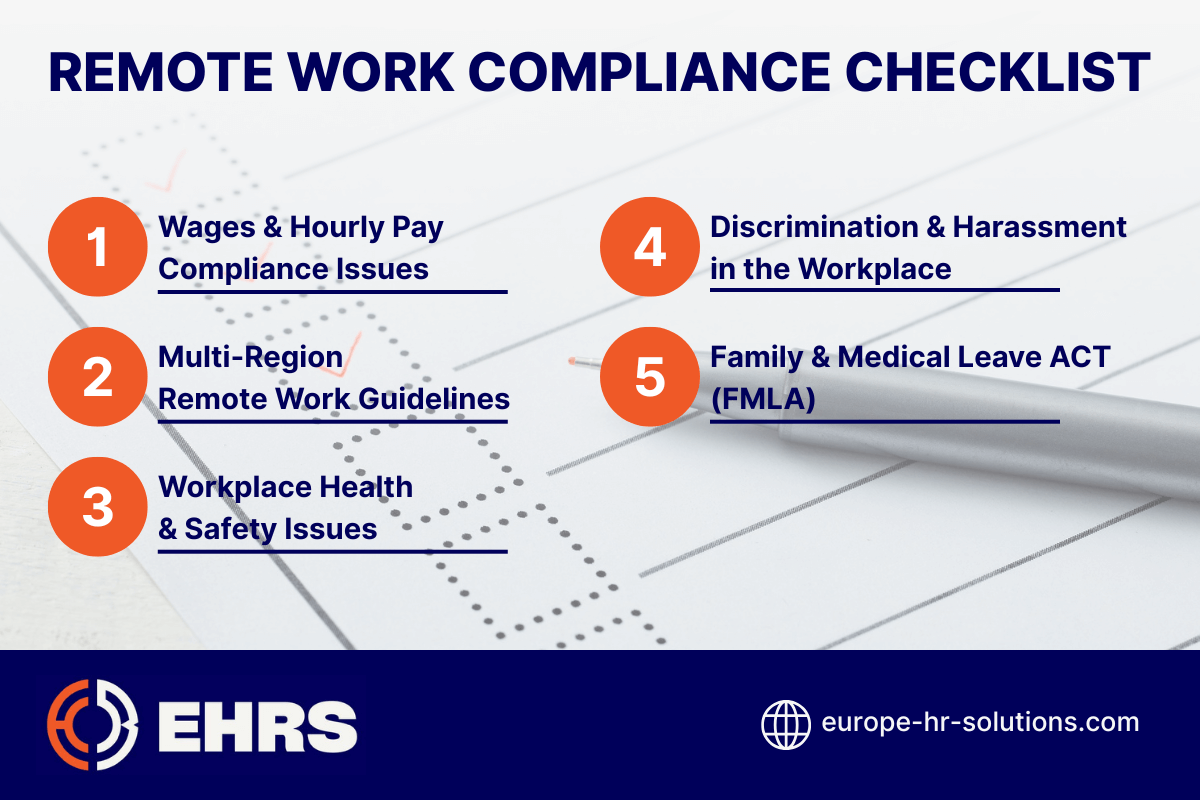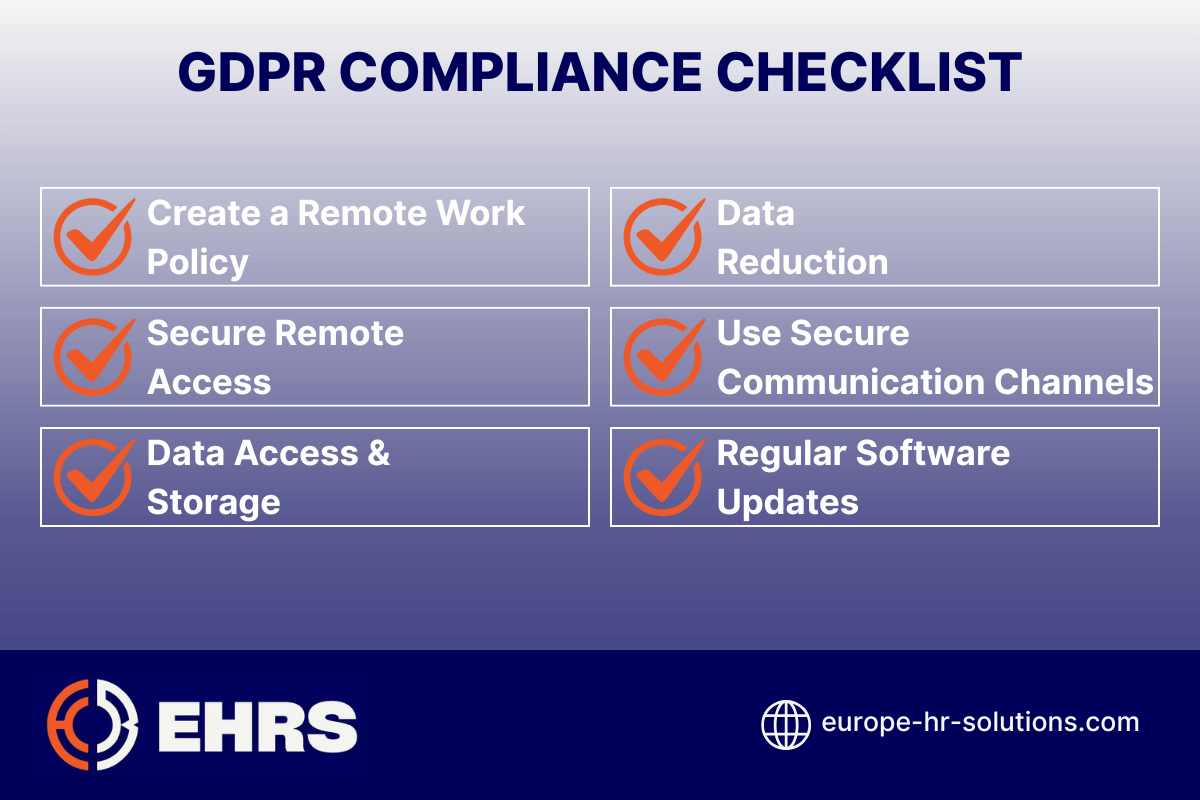Remote work has always been present within some industries, though, 5 years ago there was a widespread shift to remote work. Many companies have since embraced it and implemented it as a long-term strategy as it offers numerous advantages.
However, as with any work setting, working from home is not a situation that is immune to compliance issues.
For these reasons, we’ve decided to create a remote work compliance checklist that HR departments should be aware of and can implement in their companies.
After all, just because your team isn’t physically present in an office, does not mean the company’s legal responsibilities are fewer. This is especially important as employee claims against businesses are on the rise, meaning the risks are greater than ever before.
So let’s break this topic down and see what a company needs to follow in order to be compliant for remote workers.
What is Remote Work Compliance?
Remote work compliance refers to a set of regulatory and legal guidelines and requirements that companies need to follow when managing their remote employees. These include labor laws, data protection, tax regulations, workplace safety, and employee classification.
Basic Remote Work Compliance Checklist
To ensure compliance and help an organization avoid penalties, fines, or legal risks, the HR department needs to create remote work guidelines and practices that are lawful and applicable to all remote workers.
Here’s how to go about it:

1. Wages & Hourly Pay Compliance Issues
The federal Fair Labor Standards ACT (FLSA) sets a criteria for minimum wage, though wage and hour laws can vary depending on country or state.
This is one of the most important rules and is why it is the number one item on our remote work safety checklist. It creates a complex compliance issue that may span local, state, and even federal regulations, giving headaches to employers who manage remote teams.
With that in mind, knowing where remote employees are located is vital to understanding regional wage requirements. Moreover, proper classification, such as part-time or full-time is also important, regardless if the employee works from home or in an office.
What Can HR Departments Do:
To ensure full compliance with hour and wage regulations for remote workers, HR departments should take the following steps:
- Use an integrated payroll and time tracking system to monitor hours worked, breaks used, and overtime (if applicable)
- Properly classify employees as part-time or full-time based on employment agreements and internal HR policies
- Keep accurate records of employees’ home or work locations to adhere to local wage laws or jurisdictional guidelines
2. Multi-Region Remote Work Guidelines
Managing a remote workforce across different countries and continents, especially in Europe, can become quite complicated. The legal obligations multiply significantly, from tax benefits to payroll, wage laws, and anti discrimination guidelines, every state and country has different rules.
It is quite challenging to navigate these waters, though it is quite manageable, provided the company follows the proper approach.
To do so, the company needs to first embrace remote work and remain compliant, taking extra steps when hiring across different states and countries. These policies include the following:
- Unemployment Benefits – navigating unemployment insurance can become complex, and HR needs to ensure all claims are review and filed correctly in the location where the employee works
- Local Employment Laws – regulations that cover medical leave, paid leave, and wage standards where employers need to stay compliant with the relevant local and state guidelines
- Health Insurance Coverage – these are region-specific, meaning it is important to confirm a health insurance plan with adequate coverage in the area where the employee works
What Can HR Department Do:
The above mentioned points signal important challenges for multi-region companies, but they are just one small portion of the remote work compliance checklist.
There are more concrete steps employers can take to ensure full compliance, while minimizing risk in the process, such as the following:
- Unemployment Benefits – companies need to follow the provisions from the Department of Labor in the correct state or country in order to file unemployment claims and gather necessary information of regulatory laws and guidelines
- Health Insurance – companies need to ensure the health insurance plans meet the ACA requirements, offer significant coverage, and comply with local, state, and regional laws
- State Labor Laws – lastly, companies need to research the laws in every state and country where employees are located and create comprehensive guidelines that would cover wages, benefits, leave policies, and other requirements
3. Workplace Health & Safety Issues
Numerous compensation cases have shown that employers are also liable for providing coverage if an employee gets injured while working remotely.
The definition of a work environment, under the Occupational Safety and Health Administration (OSHA) guidelines, includes remote employees’ home offices.
This interpretation, though, is subject to variance and different legal perspectives, but it is still a vital component of a remote work safety checklist.
What Can HR Department Do:
To ensure there is no confusion and the laws are clear, employers should do the following:
- Job Descriptions & Expectations – regularly update the job descriptions and clarify the expectations regarding work related activities and tasks
- Employee Education – regularly educate employees on their role in keeping a work environment safe and healthy, while focusing on remote specific safety protocols
- Provide Stipends – offering stipends to help employees set up a safe and sound home workspace can go a long way in keeping compensation cases out of the company
4. Discrimination & Harassment in the Workplace
Many people believe that discrimination and harassment cases are only present within an office environment.
However, employees can just as well experience discrimination or harassment even when working from home.
For example, co-workers might display inappropriate attire during an online conference. Alternatively, various offensive comments and discriminatory language can be used while communicating via official chat tools. Division between in-office vs remote employees can also occur that would lead to unequal treatment.
These are all prime examples of what a company has to deal with on a daily basis.
What Can HR Department Do:
To prevent any differences in treatment or the escalation of discrimination/harassment, a company needs to take the following steps:
- Standard Benefits & Employment Terms – ensure all employees receive the same terms of employment and benefits without any sort of discrimination, regardless of work setting
- Harassment Prevention Training – implementation of a harassment prevention training can be a vital part in the hiring process to ensure all employees understand the importance of a safe and respectful working environment
- Compliance with Legal Guidelines – local, state, and federal laws have specific guidelines for harassment and discrimination that employees, managers, and HR professionals need to recognize, understand, and comply with
5. Family & Medical Leave ACT (FMLA)
Remote workers are eligible for FMLA benefits under the same conditions as in-office employees are eligible.
To qualify for FMLA, though, the employees need to meet the following criteria:
- Duration of Employment – employees must have worked for at least 12 months for the same employer
- Working Hours – employees need to have completed at least 1,250 working hours in total
- Size and Proximity – employers need to have at least 50 employees within a 120 km (75 miles) of the official office location
For remote workers, their physical work location may fall outside the 120 km (75 miles) radius that is required for FMLA eligibility.
What Can HR Department Do:
To ensure compliance with FMLA guidelines, companies need to take note of the following:
- Employee Information – tracking and keeping detailed records of employee data, such as their work location will accurately determine their eligibility for FMLA
- ADA & FMLA Intersection – in the US, the Equal Employment Opportunity Commission (EEOC) has authority to review which workers are eligible for FMLA so that they will not overlap with the Disabilities Act (ADA), meaning due diligence is required from the employer
GDPR Compliance for Remote Work Settings
With remote work becoming a global option, it is vital to ensure GDPR compliance is in place to protect personal data and maintain customer trust.
The following remote work compliance checklist details which steps companies can take to ensure work practices align with GDPR regulations:
1. Create a Remote Work Policy – this policy should include data security and privacy guidelines, and detail how employees should manage their personal data, how to interact with their co-workers in a secure manner, and how to use company technology.
2. Secure Remote Access – employees will need to stop using personal devices that may have inadequate security as it would make them vulnerable to cyber threats:
- Ensure employees have secure access to all corporate systems
- Use VPNs and encryption to protect data
- Implement multi factor authentication to prevent unauthorized access
- Regularly update software to address potential security flaws
3. Data Access & Storage – to avoid corporate data being compromised, ensure the following:
- Secure access to all corporate resources for remote workers
- Create clear guidelines on how to safely access corporate data
4. Data Reduction – this is a good policy to have in place as data minimization may have a direct impact on data loss, so regularly review and delete personal data that is no longer required for company operations.
5. Use Secure Communication Channels – it is vital to ensure secure file sharing, messaging tools, and encrypted email in order to protect sensitive information.
6. Regular Software Updates – make sure employees conduct regular updates to the software and its application to filter out and prevent any security vulnerabilities.

How to Ensure Compliance For Remote Working
A well crafted and functional remote work policy is of paramount importance to maintain full compliance with a remote workforce.
Companies need to ensure that their policies address all key areas, including the following:
- Work schedules and timekeeping
- Clear definitions of the work environment
- Workplace safety requirements and injury reporting procedures
- Employee classification standards
- Virtual behavior expectations and ethical guidelines
- Anti-harassment and anti-discrimination protocols
Fortunately, companies do not need to manage HR compliance alone. We at Europe HR Solutions are here to help you stay informed on all changes, offer guidance and advice on the best practices, and assist with strategy and planning.
Our services include regular reviews and audits of your procedures and policies, or can help you create them from scratch to ensure full compliance.
So don’t hesitate and book a free consultation and one of our experts will jump in and address all your questions regarding remote work compliance and guidelines.
How Europe HR Solutions Can Help UK & US Companies
Europe HR Solutions offers specialized HR assistance for small and mid-sized businesses that want to transition their operations into Europe.
The plethora of successful stories and HR assignments speak volumes about the expertise behind Europe HR, as the aim is to educate and help companies understand and navigate the complexities and distinctions of European labor laws and employee regulations.
Europe HR Solutions provides many different types of training to help in-house HR professionals to implement continuous learning with the following leadership coaching programs:
- Leadership development
Leadership consulting
Mentorship programs
Functional training for HR professionals
Compliance training for HR managers
How to Connect with Europe HR Solutions
Europe HR Solutions understands the need for a business to operate with an efficient HR system in place.
With a knowledgeable staff, efficient support, and innovative HR solutions, small to mid-sized North American companies can expand their operations into Europe seamlessly and successfully.
Connect with Europe HR Solutions today, book a free consultation, and an expert team with decades of HR experience will address every question and need regarding expansion into Europe.





